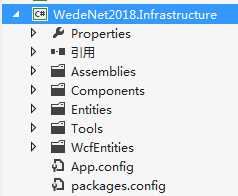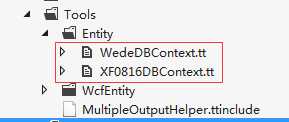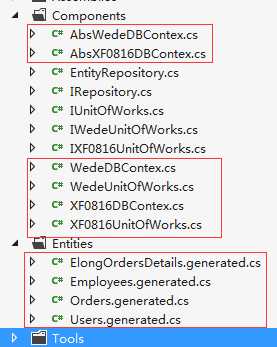标签:而在 task 插入 str exce [] model 并且 return
WedeNet2018.Infrastructure-基础设施层:
结构如下:
Tools结构如下:

考虑到系统可能会有多个数据上下文(暂时以两个为例),所以根据需要定义两个T4模板用来生成对应的entities和dbcontext类,每个T4模板对应一个数据库连接,这些数据库连接配置在应用层的配置文件中(如UI层web.config或者WCF寄宿层的app.config)。
生成的结果如下:
在此,我把UnitOfWork和Repository都看做为组件,和它们所依赖的dbcontext都统一放在了Components目录下。
仓储需要包装不同的EF entitiy,自然需要定义为泛型接口,如下:
using System;
using System.Collections.Generic;
using System.Linq;
using System.Linq.Expressions;
using System.Text;
using System.Threading.Tasks;
namespace WedeNet2018.Infrastructure.Components
{
public interface IRepository<T>
where T : class
{
IQueryable<T> All();
IQueryable<T> Filter(Expression<Func<T, bool>> predicate);
T Find(params object[] keys);
T Find(Expression<Func<T, bool>> predicate);
void Insert(T t);
void Insert(IEnumerable<T> entities);
void Delete(T t);
void Delete(IEnumerable<T> entities);
void Update(T t);
void Update(IEnumerable<T> entities);
void Clear();
}
}
接口的实现如下:
using System;
using System.Collections.Generic;
using System.Data;
using System.Data.Entity;
using System.Linq;
using System.Linq.Expressions;
using System.Text;
using System.Threading.Tasks;
namespace WedeNet2018.Infrastructure.Components
{
public class EntityRepository<TContext,TEntity> : IRepository<TEntity>
where TContext : DbContext
where TEntity : class
{
protected TContext context;
protected DbSet<TEntity> dbSet;
public EntityRepository(TContext dbContext)
{
context = dbContext;
dbSet = context.Set<TEntity>();
}
protected virtual TContext Context { get { return context; } }
protected virtual DbSet<TEntity> DbSet { get { return dbSet; } }
/// <summary>
/// 查询全部当前实体数据集
/// </summary>
/// <returns>IQueryable集合</returns>
public virtual IQueryable<TEntity> All()
{
return DbSet.AsQueryable();
}
/// <summary>
/// 条件查询当前实体数据集
/// </summary>
/// <param name="predicate">查询条件</param>
/// <returns>IQueryable集合</returns>
public virtual IQueryable<TEntity> Filter(Expression<Func<TEntity, bool>> predicate)
{
return DbSet.Where(predicate).AsQueryable<TEntity>();
}
/// <summary>
/// 查找指定主键的数据
/// </summary>
/// <param name="keys">指定主键</param>
/// <returns>符合编号的记录,不存在返回null </returns>
public virtual TEntity Find(params object[] keys)
{
return DbSet.Find(keys);
}
/// <summary>
/// 查找指定条件的单条数据
/// </summary>
/// <param name="predicate">查询条件</param>
/// <returns>返回符合条件的数据,或者null</returns>
public virtual TEntity Find(Expression<Func<TEntity, bool>> predicate)
{
return DbSet.FirstOrDefault(predicate);
}
/// <summary>
/// 上下文中插入单个实体
/// </summary>
/// <param name="entity"></param>
public virtual void Insert(TEntity entity)
{
if (Context.Entry(entity).State == EntityState.Detached)
{
Context.Entry(entity).State = EntityState.Added;
//DbSet.Add(entity);
}
}
/// <summary>
/// 上下文中批量插入实体
/// </summary>
/// <param name="entities"></param>
public virtual void Insert(IEnumerable<TEntity> entities)
{
try
{
Context.Configuration.AutoDetectChangesEnabled = false;
foreach (TEntity entity in entities)
{
Insert(entity);
}
}
finally
{
Context.Configuration.AutoDetectChangesEnabled = true;
}
}
/// <summary>
/// 上下文中删除单个实体
/// </summary>
/// <param name="entity"></param>
public virtual void Delete(TEntity entity)
{
if (Context.Entry(entity).State == EntityState.Detached)
{
DbSet.Attach(entity);
}
DbSet.Remove(entity);
}
/// <summary>
/// 上下文中批量删除实体
/// </summary>
/// <param name="entities"></param>
public virtual void Delete(IEnumerable<TEntity> entities)
{
try
{
Context.Configuration.AutoDetectChangesEnabled = false;
foreach (TEntity entity in entities)
{
Delete(entity);
}
}
finally
{
Context.Configuration.AutoDetectChangesEnabled = true;
}
}
/// <summary>
/// 上下文中更新单个实体
/// </summary>
/// <param name="entity"></param>
public virtual void Update(TEntity entity)
{
if (Context.Entry(entity).State == EntityState.Detached)
{
DbSet.Attach(entity);
}
Context.Entry(entity).State = EntityState.Modified;
}
/// <summary>
/// 上下文中批量更新实体
/// </summary>
/// <param name="entities"></param>
public virtual void Update(IEnumerable<TEntity> entities)
{
try
{
Context.Configuration.AutoDetectChangesEnabled = false;
foreach (TEntity entity in entities)
{
Update(entity);
}
}
finally
{
Context.Configuration.AutoDetectChangesEnabled = true;
}
}
public virtual void Clear()
{
}
}
}
在这个仓储基类里,引入了该仓储依赖的dbcontext,这个dbcontext会在系统初始化该仓储的时候传入,并且是单例的。这样才能保证UnitOfWork操作的一致性。
另外,针对不同的dbcontext,我也定义了对应的抽象类,如:
目的是在做IOC的时候一个具体类型必须对应一个基类,而在这两个抽象类内部都继承了DbContext,如:
// <auto-generated>
// 此代码由工具生成。
// 对此文件的更改可能会导致不正确的行为,并且如果
// 重新生成代码,这些更改将会丢失。
// 如存在本生成代码外的新需求,请在相同命名空间下创建同名分部类进行实现。
// </auto-generated>
using System;
using System.Collections.Generic;
using System.Linq;
using System.Data.Entity;
using System.ComponentModel.DataAnnotations.Schema;
using System.ComponentModel.DataAnnotations;
namespace WedeNet2018.Infrastructure
{
public abstract class AbsWedeDBContex:DbContext
{
//连接字符串名称:基于Config文件中连接字符串的配置
const string connectionStringName = "constring";
public AbsWedeDBContex()
: base(connectionStringName)
{
}
}
}
接下来就是UnitOfWork,接口定义如下:
using System;
using System.Collections.Generic;
using System.Linq;
using System.Linq.Expressions;
using System.Text;
using System.Threading.Tasks;
namespace WedeNet2018.Infrastructure.Components
{
/// <summary>
/// 定义工作单元统一接口
/// </summary>
public interface IUnitOfWorks
{
IQueryable<T> Where<T>(Expression<Func<T, bool>> predicate) where T : class;
IQueryable<T> All<T>() where T : class;
T Find<T>(object id) where T : class;
T Find<T>(Expression<Func<T, bool>> predicate) where T : class;
void Add<T>(T t) where T : class;
void Add<T>(IEnumerable<T> items) where T : class;
void Update<T>(T t) where T : class;
void Update<T>(IEnumerable<T> items) where T : class;
void Delete<T>(T t) where T : class;
void Delete<T>(IEnumerable<T> items) where T : class;
void Clear<T>() where T : class;
bool IsCommitted { get; }
int Commit();
}
}
和上面定义了两个dbcontext抽象基类一样,出于IOC考虑,这里也定义了两个实现了IUnitOfWorks接口的接口,如:
下面是对应的实现类,如:
using System;
using System.Collections.Generic;
using System.Data.Entity;
using System.Data.Entity.Infrastructure;
using System.Data.SqlClient;
using System.Linq;
using System.Linq.Expressions;
using System.Text;
using System.Threading.Tasks;
using WedeNet2018.Common;
namespace WedeNet2018.Infrastructure.Components
{
/// <summary>
/// 实现一个工作单元,将使用NInject注册为单例
/// </summary>
/// <typeparam name="TDBContext">该工作单元使用的数据上下文类型</typeparam>
public class XF0816UnitOfWorks<TDBContext> : IXF0816UnitOfWorks, IDisposable
where TDBContext : DbContext
{
protected TDBContext dbContext;
public XF0816UnitOfWorks(TDBContext context)
{
dbContext = context;
}
//构造通用的Repository
private IDictionary<Type, object> repositoryTable = new Dictionary<Type, object>();
//注册其它的Repository
public void Register<T>(IRepository<T> repository) where T : class
{
var key = typeof(T);
if (!repositoryTable.ContainsKey(key))
repositoryTable.Add(key, repository);
}
private IRepository<T> GetRepository<T>()
where T : class
{
IRepository<T> repository = null;
var key = typeof(T);
if (repositoryTable.ContainsKey(key))
repository = (IRepository<T>)repositoryTable[key];
else
{
repository = GenericRepository<T>();
repositoryTable.Add(key, repository);
}
return repository;
}
protected virtual IRepository<T> GenericRepository<T>() where T : class
{
return new EntityRepository<TDBContext, T>(dbContext);
}
/// <summary>
/// 条件查询当前实体数据集
/// </summary>
/// <typeparam name="T">实体类型</typeparam>
/// <param name="predicate">查询条件</param>
/// <returns>IQueryable集合</returns>
public System.Linq.IQueryable<T> Where<T>(Expression<Func<T, bool>> predicate)
where T : class
{
return GetRepository<T>().Filter(predicate);
}
/// <summary>
/// 查询全部当前实体数据集
/// </summary>
/// <typeparam name="T">实体类型</typeparam>
/// <returns>IQueryable集合</returns>
public System.Linq.IQueryable<T> All<T>() where T : class
{
return GetRepository<T>().All();
}
/// <summary>
/// 查找指定主键的数据
/// </summary>
/// <typeparam name="T">实体类型</typeparam>
/// <param name="id">实体主键</param>
/// <returns>符合编号的记录,不存在返回null</returns>
public T Find<T>(object id) where T : class
{
return GetRepository<T>().Find(id);
}
/// <summary>
/// 查找指定条件的单条数据
/// </summary>
/// <typeparam name="T">实体类型</typeparam>
/// <param name="predicate">查询条件</param>
/// <returns>返回符合条件的数据,或者null</returns>
public T Find<T>(Expression<Func<T, bool>> predicate) where T : class
{
return GetRepository<T>().Find(predicate);
}
/// <summary>
/// 上下文中插入单个实体
/// </summary>
/// <typeparam name="T">实体类型</typeparam>
/// <param name="t">实体</param>
public void Add<T>(T t) where T : class
{
GetRepository<T>().Insert(t);
}
/// <summary>
/// 上下文中批量插入实体
/// </summary>
/// <typeparam name="T">实体类型</typeparam>
/// <param name="items">实体集合</param>
public void Add<T>(IEnumerable<T> items) where T : class
{
GetRepository<T>().Insert(items);
}
/// <summary>
/// 上下文中更新单个实体
/// </summary>
/// <typeparam name="T">实体类型</typeparam>
/// <param name="t">实体</param>
public void Update<T>(T t) where T : class
{
GetRepository<T>().Update(t);
}
/// <summary>
/// 上下文中批量更新实体
/// </summary>
/// <typeparam name="T">实体类型</typeparam>
/// <param name="items">实体集合</param>
public void Update<T>(IEnumerable<T> items) where T : class
{
GetRepository<T>().Update(items);
}
/// <summary>
/// 上下文中删除单个实体
/// </summary>
/// <typeparam name="T">实体类型</typeparam>
/// <param name="t">实体</param>
public void Delete<T>(T t) where T : class
{
GetRepository<T>().Delete(t);
}
/// <summary>
/// 上下文中批量删除实体
/// </summary>
/// <typeparam name="T">实体类型</typeparam>
/// <param name="items">实体集合</param>
public void Delete<T>(IEnumerable<T> items) where T : class
{
GetRepository<T>().Delete(items);
}
public void Clear<T>() where T : class
{
GetRepository<T>().Clear();
}
/// <summary>
/// 当前单元操作是否已被提交
/// </summary>
public bool IsCommitted { get; private set; }
/// <summary>
/// 提交当前工作单元
/// </summary>
/// <returns></returns>
public int Commit()
{
try
{
int result = dbContext.SaveChanges();
return result;
}
catch (DbUpdateException e)
{
if (e.InnerException != null && e.InnerException.InnerException is SqlException)
{
SqlException sqlEx = e.InnerException.InnerException as SqlException;
string msg = SqlDataHelper.GetSqlExceptionMessage(sqlEx.Number);
throw PublicHelper.ThrowDataAccessException("提交数据更新时发生异常:" + msg, sqlEx);
}
throw;
}
}
public void Dispose()
{
if (dbContext != null)
{
dbContext.Dispose();
}
GC.SuppressFinalize(this);
}
}
}
到此为止,Infrastructure-基础设施层已经构建好了。
标签:而在 task 插入 str exce [] model 并且 return
原文地址:https://www.cnblogs.com/zhaow/p/9399434.html